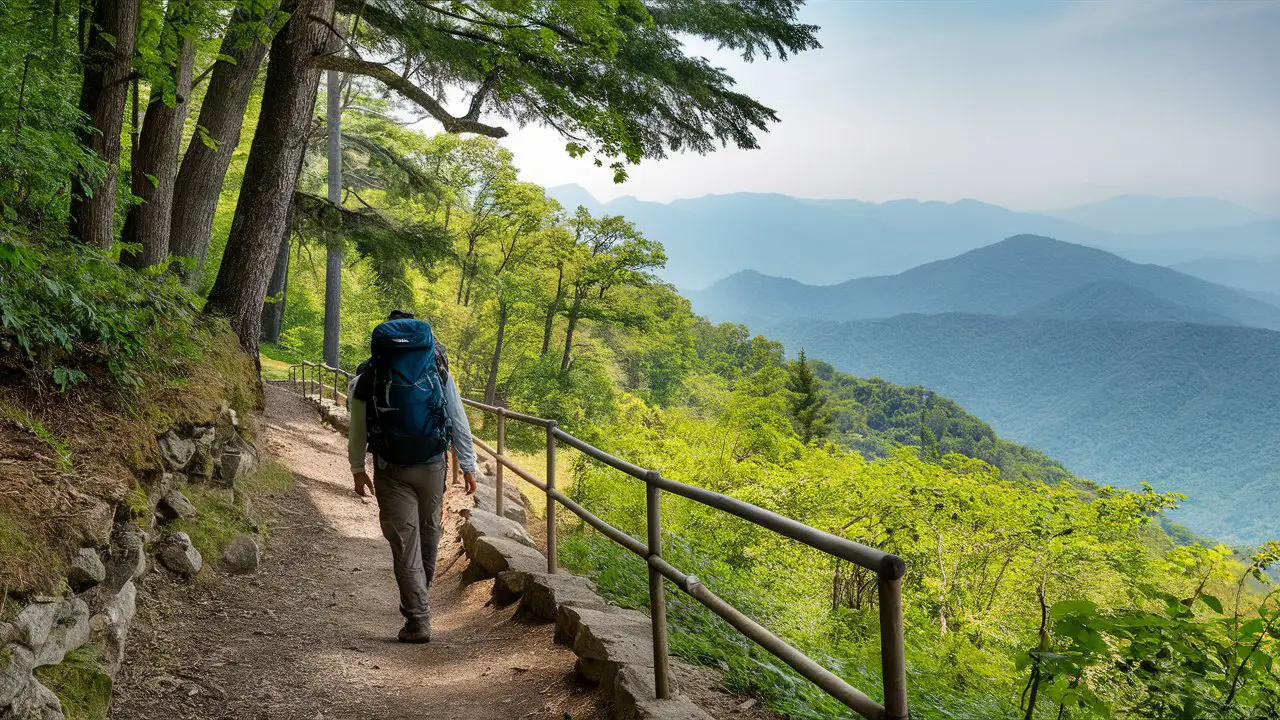As you prepare to explore the beautiful trails and majestic scenery of Great Smoky Mountains National Park, it’s important to keep safety in mind. With over 800 miles of hiking trails traversing rugged, remote terrain, this jewel of the Southeast offers adventure for hikers of all skill levels. However, the changeable weather, rocky footing, and potential wildlife encounters can pose hazards if you’re not adequately prepared. Use this guide of safety tips to plan your hiking excursions in “the Smokies” so you can fully immerse yourself in the wonders of nature while minimizing risks. Following basic precautions and packing proper gear tailored to the unique demands of Smoky Mountains hikes will help ensure your treks are enjoyable and incident-free.
Essential Gear to Pack for Hiking in the Great Smoky Mountains
To have an enjoyable and safe hike in the Smokies, you must be properly equipped. ###Hiking boots with ankle support are essential for the variable mountain terrain. Waterproof boots will keep your feet dry in case of rain or stream crossings. Carry comfortable hiking socks, a map of the trail, compass, pocket knife, water bottle, snacks, rain jacket, hat, sunscreen, bug spray, a basic first aid kit, flashlight or headlamp, lighter or waterproof matches, and a backpack to carry it all.
For longer hikes, also pack a tent, sleeping bag, sleeping pad, camp stove, food, and other overnight essentials. Check if camping is allowed on your route. ###Trekking poles or a walking stick can aid balance on rocky or uneven trails. Binoculars allow you to view wildlife and scenic vistas from a distance. A pocket reference book about local plants and animals will help you identify what you encounter on the trail.
Proper clothing includes breathable and moisture-wicking base layers, hiking pants or shorts, and layers like a fleece jacket. Synthetic or wool fabrics are better than cotton which stays damp. Gloves or mittens and a winter hat are useful even in warmer months at higher elevations.
Whether you plan to hike for a couple hours or several days, preparing well will allow you to travel light yet have everything you need. By bringing essential gear, clothing, and other hiking essentials, you’ll be ready to fully experience the wonder and challenge of the Great Smoky Mountains. With the proper precautions taken, you can embark on an enjoyable hiking adventure in one of America’s most stunning national parks.
Top 5 Day Hikes in the Smoky Mountains National Park
Clingmans Dome Trail
The highest point in the Great Smoky Mountains National Park, Clingmans Dome offers stunning 360-degree views from its observation tower. The half-mile hike to the tower is moderately strenuous but rewarding. Start from the large parking lot and follow the paved path to the tower at the top of the mountain. Along the way, you’ll pass through a spruce-fir forest and may spot birds like ravens, blue jays, and hawks.
Abrams Falls Trail
This moderate 5-mile roundtrip hike follows Abrams Creek to a scenic 20-foot waterfall. From the parking area, the trail descends through a lush hardwood forest, passing several creek crossings along the way. The trail terminates at the base of Abrams Falls, a wide cascade framed by massive boulders. This hike is especially beautiful in spring and fall when the leaves are changing colors.
Rainbow Falls Trail
Another picturesque waterfall hike, the Rainbow Falls Trail is 3.8 miles roundtrip. The trail begins from the Rainbow Falls parking area, ascending through oak and hemlock forest. About 1.3 miles in, the trail emerges at the base of Rainbow Falls, an 80-foot cascade that often produces rainbows in its mist. The best views are from the trail bridge directly in front of the falls. This strenuous hike can be slippery when wet, so wear proper footwear.
Charlies Bunion Trail
For stunning views of the Tennessee and North Carolina mountains, hike the 8-mile Charlies Bunion Trail. The trail starts from the Newfound Gap parking area, climbing over rocky terrain to the Charlies Bunion overlook at 6,210 feet, which provides panoramic vistas. The hike passes through spruce-fir forest before emerging onto exposed rocks. Given the strenuous and challenging nature of this hike, only experienced hikers should attempt it.
Cades Cove Loop
Cades Cove is one of the most popular destinations in the park. The 11-mile Cades Cove Loop Trail circles the cove, providing opportunities to spot wildlife like deer, turkeys, and black bears. The mostly flat loop passes historic cabins, churches, and grist mills from the early 19th century. Hike or bike the loop road, or explore some of the side trails for a longer hike. The cove is open to vehicles on Wednesdays and Saturdays until 10 am, so aim to arrive early.
Tips for Staying Safe While Hiking in the Smokies
When embarking on a hiking adventure in Great Smoky Mountains National Park, safety should be your top priority. The Smokies contain miles of rugged terrain, extreme elevations, and remote wilderness — so preparation is key. ###Plan Your Hike Carefully
Do thorough research on the trail you want to hike before you go. Know the trail length, difficulty, and terrain. Check the park’s website for any trail warnings or closures. Map your route and consider bringing a compass and physical map as a backup. Let someone know your plans before you head out on longer hikes. ###Dress Appropriately for the Conditions
The weather in the Smokies can change quickly, especially at higher elevations. Wear proper hiking boots, moisture-wicking clothes, and layers you can adjust. Pack a waterproof jacket, hat, gloves and additional layers in your daypack. ###Stay on Marked Trails
It’s easy to get lost in the dense forest, so stick to established hiking trails. Pay attention to trail blazes and signs to avoid straying off course. If you do become lost, stay in one place to make it easier for rescue teams to locate you.###Watch Out for Wildlife
Black bears, snakes, and insects are common in the park. Make noise while hiking to avoid surprising any wildlife. Keep food stored properly and your campsite clean to deter animals. Never approach or corner wild animals, especially if babies or dens are present. ###Hydrate and Refuel
The strenuous terrain in the Smokies demands proper hydration and nutrition. Bring plenty of water and high-energy snacks like nuts, jerky, and protein bars. Start your hike with a full breakfast and stop for lunch on longer trails. Rest when you need to avoid exhaustion or altitude sickness.
By following these essential tips, you’ll be well on your way to enjoying a safe and memorable hiking adventure in the Great Smoky Mountains. Take in the stunning views and natural surroundings, but do so responsibly by being prepared for any situation. Your safety in this wilderness area depends on your own good judgement and decisions. Have a great hike!

Best Times of Year to Go Hiking in the Great Smoky Mountains
The Great Smoky Mountains National Park is open year-round, offering stunning scenery regardless of the season. However, some times of year are more ideal for hiking than others, based on factors like weather, crowds, and wildlife activity.
Spring (March to May)
Spring in the Smokies brings blooming wildflowers, warmer weather, and smaller crowds as the busy summer season has not yet started. Temperatures are mild, ranging from the 50s to 70s Fahrenheit, with low chances of rain. You may spot black bears emerging from hibernation with their cubs. Popular trails like the Chimney Tops and Alum Cave Bluffs trails will still be open before the summer closure for falcon nesting season.
Fall (September to November)
Autumn is one of the most stunning times to hike in the Smokies, with the park’s foliage transforming into vibrant reds, oranges and golds. Crowds dwindle after Labor Day weekend, and temperatures start to cool making hiking more comfortable. However, rainfall increases in October and November. Shorter days also mean less sunlight, so plan hikes to end before dark.
While the Smokies offer appealing hiking year-round, the spring and fall shoulder seasons from March to May and September to November often provide the best combination of smaller crowds, pleasant weather, and open trails. Summers can be hot and crowded, and winter brings greater chances of snow and ice at the higher elevations. With proper preparation for the conditions, you’ll be rewarded with a memorable hiking experience whenever you choose to visit the Great Smoky Mountains.
Great Smoky Mountains Hiking FAQs: Common Questions Answered
How long do most hikes take?
The Great Smoky Mountains National Park offers over 800 miles of trails ranging from short nature walks to long-distance backpacking treks. Most day hikes average 3 to 7 miles round trip and can take between 2 to 6 hours to complete depending on your pace and breaks. However, some of the most popular trails like Alum Cave Trail to Mount LeConte or Andrews Bald Trail can take up to 8 hours. It is best to plan your hike based on your experience and fitness level.
What essentials should I bring?
When hiking in the Smokies, be prepared for variable weather conditions and pack the ten essentials: map, compass, pocket knife, water, food, rain jacket, extra layers, fire starter, first aid kit, and headlamp. You should also bring comfortable hiking boots, bug spray, sun protection, a backpack to carry everything, and a camera to capture the scenic views.
Are permits required for hiking?
Permits are not required for most day hikes in the park. However, backcountry campers must obtain a backcountry permit for overnight stays at backcountry campsites and shelters. Permits must be obtained in person no more than 30 days in advance. A permit is also needed for a limited number of heavily-used day hikes like the Alum Cave Trail and Mount LeConte via Trillium Gap Trail between March and May.
Are pets allowed on the trails?
Dogs are permitted on most hiking trails but must be kept on a leash no longer than 6 feet at all times. Dogs are not allowed on some trails like Porter’s Creek, Ramsey Cascades, and Alum Cave Trail. It is best to check the park’s official website for the latest pet regulations before bringing your dog hiking. Owners must also properly dispose of pet waste.
Where can I find more information?
For more details on hiking in Great Smoky Mountains National Park, visit the official National Park Service website at www.nps.gov/grsm or stop by one of the park’s visitor centers. The knowledgeable staff can provide recommendations tailored to your needs and interests to help you plan a safe, enjoyable hike.
Conclusion
With over 800 miles of hiking trails winding through the lush forest of Great Smoky Mountains National Park, this natural wonderland beckons outdoor enthusiasts of all skill levels. Yet venturing deep into its remote wilderness comes with inherent risks. Following proper preparation and safety protocol will help ensure your Smoky Mountain hiking adventures create lasting memories rather than regrets. Let the tips outlined here guide your journey into the majestic backcountry. And may the wonder of this ancient landscape inspire you, while its pristine waters nourish your spirit. Return home not just invigorated in body, but renewed in mind and soul.
Don’t Miss a Thing! Enhance Your Wildlife Photography with Ultra-X Night Vision Goggles.
GET NOW!






